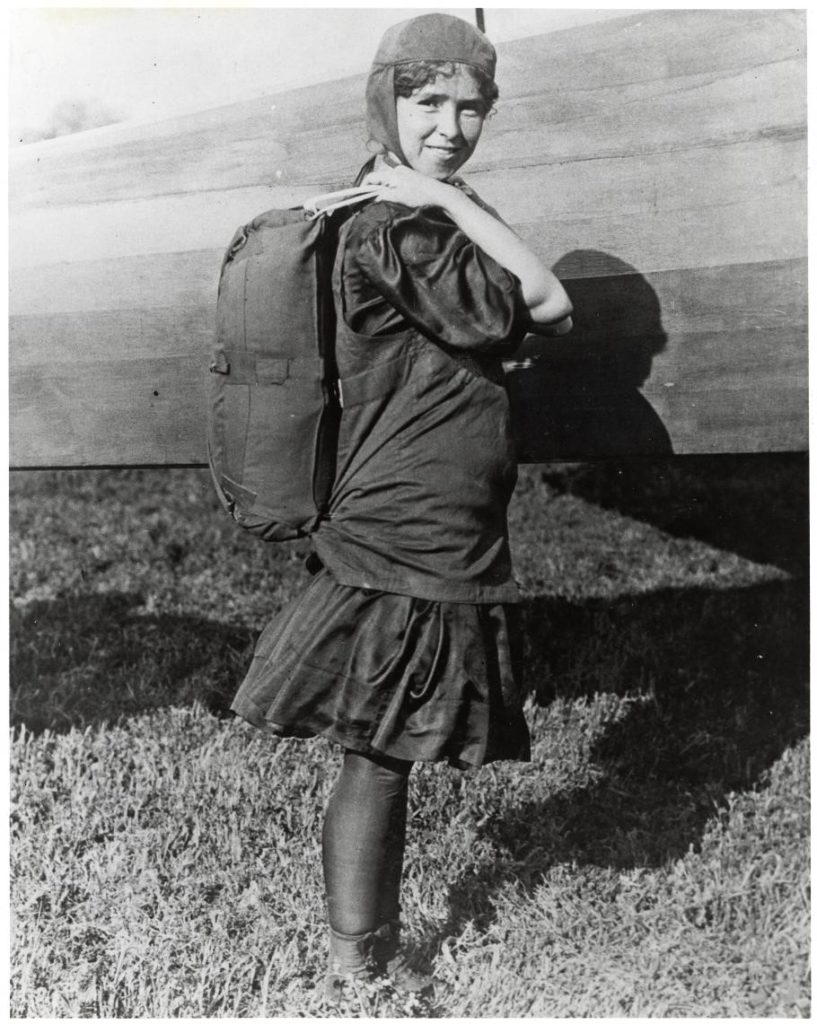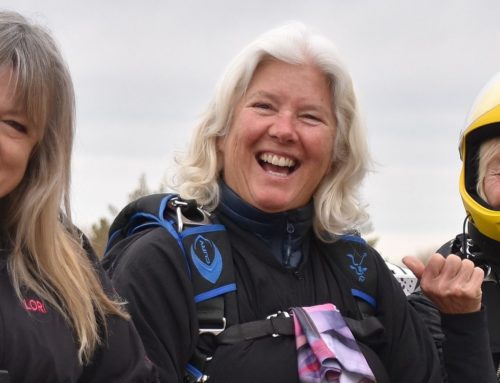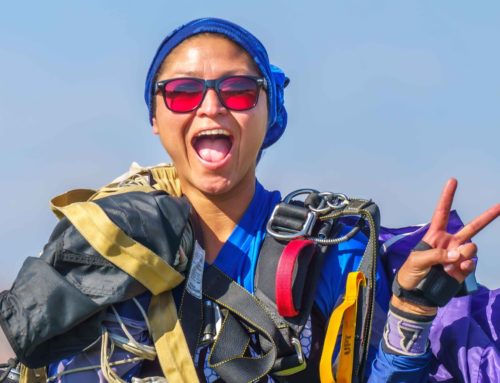Women’s History Month
March is Women’s History Month, designated to recognize the vital roles women have played throughout history. To celebrate Women’s History Month, we’d like to walk you down memory lane to introduce you to women who have helped evolve the sport as we know it – not just as the “first woman” to do something, but as the first person to do something (who just happens to be a woman). Women may only comprise 13% of USPA membership, but they have played a significant role in our sport’s history and development.
Women began contributing to the birth and evolution of skydiving as early as 1910. The earliest versions of parachutes were unable to fit in a case to be packed and worn on the back. Katharina “Käthe” Paulus, a famed German exhibition parachute jumper, changed that when she invented and patented new parachute designs. She began her aviation career as an acrobat, dazzling onlookers with her ballooning and parachuting on a team with her partner Hermann Lattemann. When Lattemann died while parachuting, Käthe became even more motivated to work on improving existing conventional parachutes. The old designs and configurations often led lines to become dangerously twisted by the wind, and parachutes required a lot of space (which was obviously challenging when jumping from balloons). Käthe had the idea to artistically fold the parachute and pack it in a cover that could be opened with a special technique. Through her technique, the parachute cloth and carrying lines were folded, packed, and fastened to allow the parachute to unfold reliably. She registered her invention with the Imperial Patent Office in Germany, and the military took notice and commissioned her to produce 7000 parachutes for the German forces in WWI. Käthe worked tirelessly, creating 125 parachutes per week! In addition to developing the first packing system for a parachute to be worn before use, Käthe is also credited with inventing the “drag ‘chute.” The drag chute was an intentional breakaway system where one small parachute opens to pull out the main parachute. Her ideas led to the birth of the modern parachute and container system, as well as the use of pilot chutes! Käthe Paulus’ work and inventions didn’t just change the landscape of the first World War, they also paved the way for the development of sport skydiving as we know it today.

Photo: Katharina “Käthe” Paulus
Several years after Käthe Paulus made her contribution to the sport, Georgia Ann “Tiny” Thompson Broadwick took parachuting even further. In 1914, Tiny Broadwick was demonstrating parachutes to the U.S. Army, since many pilots had been lost in World War I because they had no way to escape from a military airplane. On her fourth demonstration jump, the static line became entangled in the tail assembly of the aircraft, so Tiny decided to alter her next jump to turn it into the first intentional free-fall jump from a plane. She cut the static line short and did not attach it to the plane, deploying her parachute manually by pulling the unattached line in freefall. This demonstrated that pilots could safely escape aircraft by using what was later called a ripcord. Though her jump was witnessed by many, the credit for first intentional freefall is often given to stuntman Leslie Irvin, who deployed his parachute in freefall 5 years later in 1919. In addition to Tiny pioneering the ripcord and intentional freefall, she was also the first person to ever jump from a seaplane. She may have been tiny in stature and name, but her contributions were certainly huge!

Photo: Tiny Broadwick, National Air and Space Museum: https://airandspace.si.edu/multimedia-gallery/11129hjpg
The next pioneering parachutist we’d like to recognize is Adeline Gray. Adeline grew up with an interest in flight, often jumping from her hayloft using an umbrella as a child. She began making parachute jumps in 1935 at only 19 years old. Adeline went on to join a stunt parachuting team in barnstorming shows, earned her pilot’s license by 21, and then worked as a parachute rigger and tester for the DuPont chemical company. DuPont is known for creating widely used polymers such as neoprene, Mylar, Teflon, Kevlar, and nylon. Her work with DuPont led Adeline to become the first person ever to jump with a nylon parachute. Though they were previously made from Japanese silk imports, the silk shortage during World War II inspired the use of other materials for parachutes. When DuPont teamed up with the Pioneer Parachute Company and Cheney Brothers Silkmakers to develop a nylon parachute, Adeline volunteered to be the first to test it. She became the first person to jump a nylon parachute in 1942. Media reports of the jump noted her calm demeanor, with the New York Times writing: “As calmly as if she were going out on the porch to bring in the daily paper…[she] stepped out of an airplane.” That demonstration was only her 33rd jump! The senior military officials who witnessed her jump went on to advocate for and adopt the widespread use of nylon parachutes. Eighty years later, nylon is still the most popular material for parachutes.

Photo: Adeline Gray
Less than 10 years after Adeline Gray’s contribution to the sport, Monique Laroche showcased the progression of skydiving by setting the first ever FAI parachuting record. Monique Laroche became a licensed parachutist after learning to jump at only 16 years old from a 25-meter training tower in France. In 1951 at the age of 22, Monique exited an aircraft at 4235m and opened her parachute at 400m above the ground. Her freefall set the record for an altitude jump with delayed opening! She followed up that record by competing in the first World Parachuting Championships, where she earned the first world championship title for parachuting accuracy. Over the years, Monique won multiple medals and funded her jumps by appearing in airshows where she would pull her ripcord at the last possible moment without an altimeter. (We do NOT recommend this now!! Wow.) One of the other big skydiving firsts that she was a part of was the world’s first two-way skydive, made in 1955 with Leo Valentin. Her accomplishments are notable within the development of the sport as important “firsts” for all – not just for women.

Photo: Monique Laroche
Decades later, another contribution to competitive skydiving came from Deanna Kent in 1989. Deanna is known as the first skydiver to perform freestyle skydiving, when she “skydanced” in her husband Norman Kent’s 1989 film “From Wings Came Flight.” Her trademark style became a competitive skydiving discipline in the early 1990s, and it officially became an FAI sport discipline in 1996. Deanna is often referred to as “the mother of freestyle and three-dimensional flight,” and she is being inducted into the International Skydiving Hall of Fame, Class of 2022. Just as the other incredible women before her led the way in evolving our sport, Deanna and her artistry left an impact that reverberates throughout skydiving as we know it today.

Deanna “Skydancer” Kent dances over Locarno, Switzerland, during a training session. Photo by Norman Kent.
Women may make up a small percentage of skydivers, but the impact of women on the development and evolution of the sport is undeniable. Their contributions show that women are just as drawn to and inspired to innovate in flight as their male counterparts. In honor of Women’s History Month, we recognize those who have progressed skydiving to become the sport we know and love today. Women have been an instrumental part of the sport’s development, and we can’t wait to see where we take it next!





Hello my name is Peter Lynch. I’m a retired Connecticut American. I’m a historian on the Ct. parachute developments and industry.
I’m going to put Adeline Gray back on the scene on that dynamic NYLON parachute jump for the military. June 6 , 1942. The original day – the 4 or 5 was too windy. There was a live broadcast by WTIC am radio with Bob Steele – lots of people , watched as Adeline exited the plane from 2000 over Brainard Airfield, Hartford Connecticut.
I went to Tiny Broadwicks home town. They have many memorials , a road in her name. I cleaned the bottom of the street sign, overgrown I met there historian on Tinys history!
There really nothing noting Adeline’s achievements, anywhere. I talking to the Senator of Manchester next week. I’m working on getting an exhibition area at the New England Air museum located next to Bradley Airport. Trying to get on a radio station. One thing at a time. James Floyd Smith , he patented developing different containers . He was a test pilot for Glenn Curtiss. Tiny jumped from Curtis Seaplane. Smith became VP at Pioneer Parachutes. AKA Cheney Silk Mills. He was making $365,000,00. In 1943. There were problems , over patents ? He ended up leaving the company.
Thanks
BLUE SKYS
Peter Lynch
Army Parachute Rigger 1983-
Current and active skydiver
Life member Connecticut Parachutists Ellington Ct .
My father was involved in two glider invasions during WWII HE WAS jump/parachute qualified also.
Hello Peter,
I wanted to reach out to you from Capewell. Can you please email me your email address? [email protected]